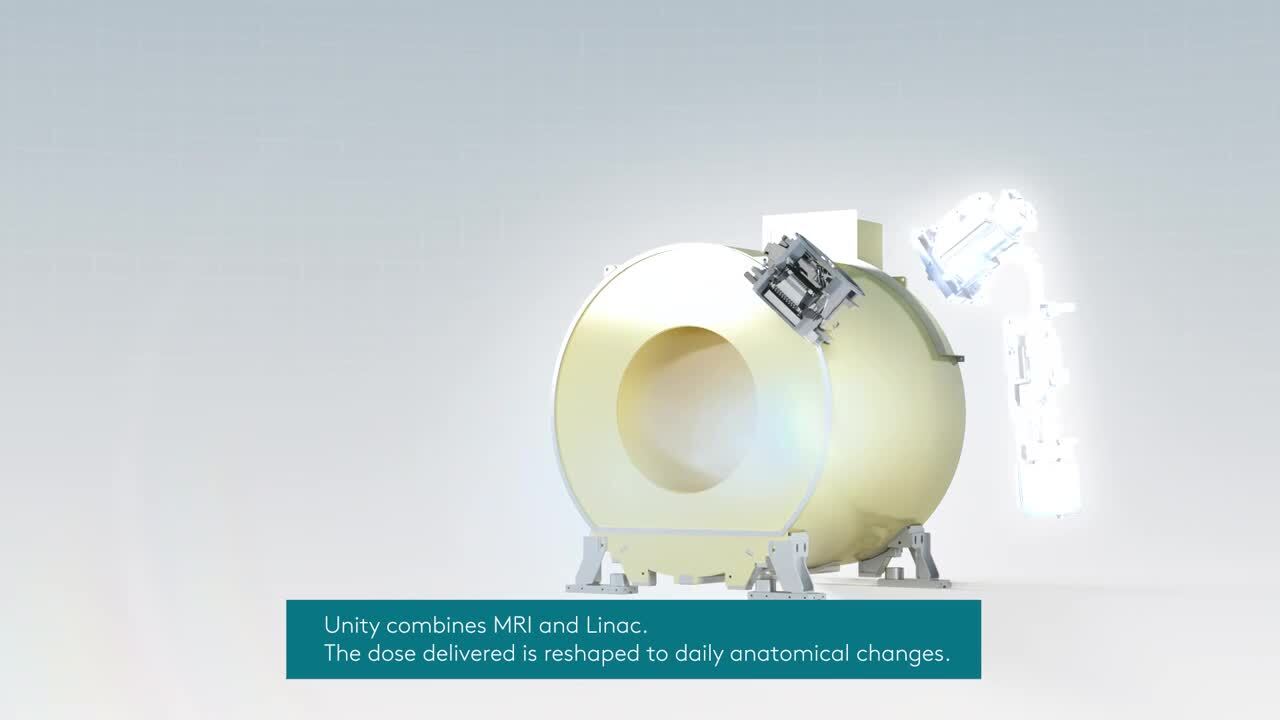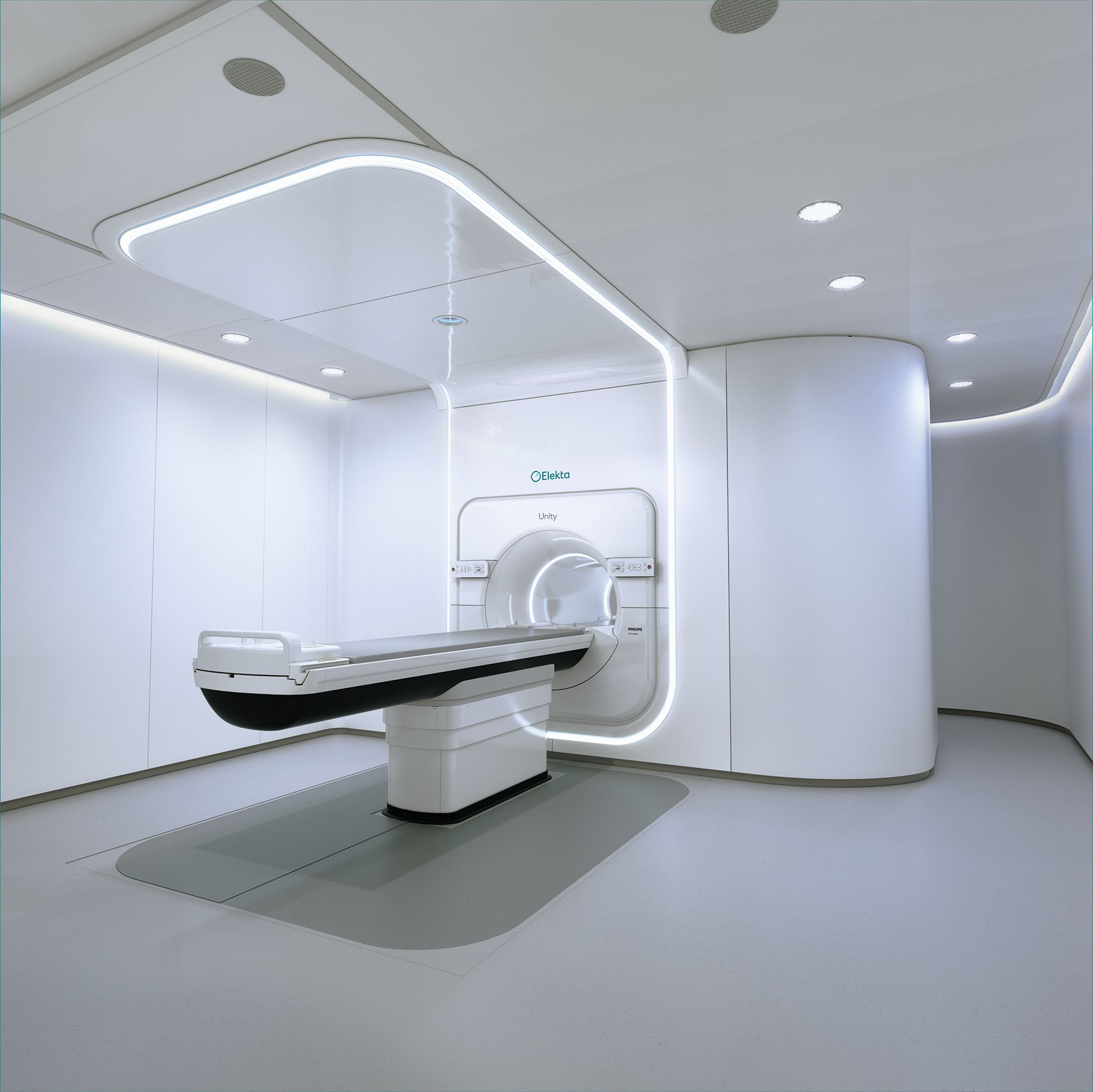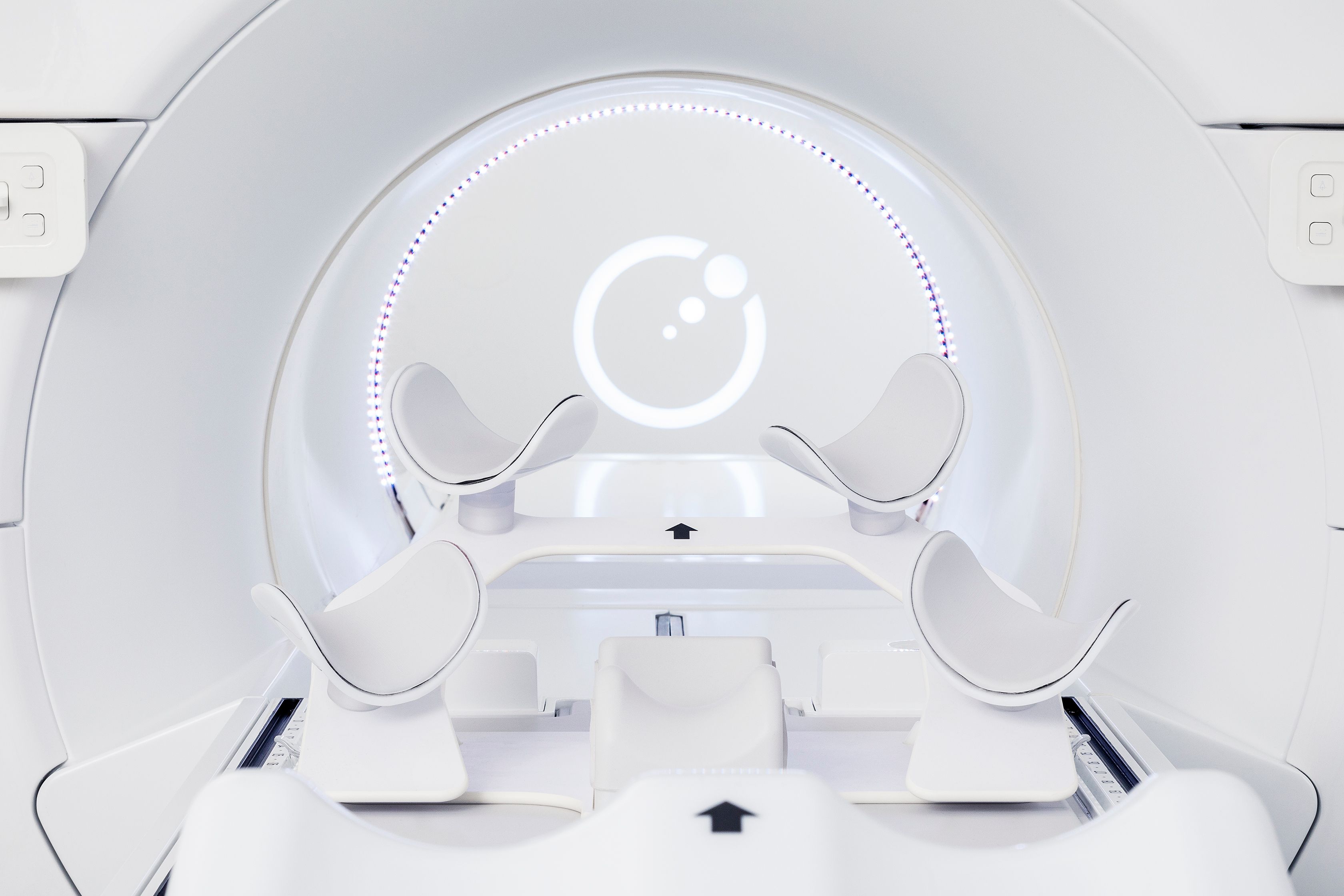MRgRT (Magnetic Resonance guided Radiation Therapy) is a new and innovative radiation treatment option that is great for moving tumors and surrounding healthy organs. It allows your clinical team to see your tumor and surrounding anatomy in incredible soft-tissue quality before treatment, and in real-time during treatment. This allows the cancer treatment to be adapted precisely to suit your anatomy in every session, which aims to reduce side effects and the number of treatment sessions you need to attend.1, 2, 3
Share your story
What is MRgRT?
Magnetic Resonance-guided Radiation Therapy (MRgRT) treatment is a new and innovative radiation option.
The clinical team can see the tumor and surrounding healthy anatomy in incredible soft tissue quality before treatment, and in real-time during treatment, which makes it great for moving tumors. This MR-Linac cancer treatment can be adapted precisely to suit your anatomy in every session, which aims to reduce side effects and the number of treatment sessions you need to attend.1, 2, 3
What is a MR-Linac?
An MR-Linac is a dedicated cancer treatment device (Linac), integrated with a magnetic resonance imaging scanner (MRI). This type of Linac allows the clinical team to see incredible detail in three-dimensions, which gives them great insights to better tailor the radiation therapy treatment to you.

MR-Linac treatment procedure
If you are to receive MR-guided radiation therapy, your clinical team will explain what will happen during your treatment, but here is a brief description of what to expect.
Consultation
Before your radiation therapy starts, your doctor will discuss the options with you, explain any side effects that you might experience, and answer any questions you might have. It’s a good idea to write your questions down before you go and to take notes during your visit.
Simulation
Special images are taken of the inside of your body to help plan your treatment accurately. They might be obtained using a CT scanner (computed tomography), and or an MRI scanner (magnetic resonance imaging). These images will show the location, size and shape of the tumor, and any affected or nearby organs so that your treatment team can target cancer cells as precisely as possible.
You will be lying in a position suitable for your treatment with specialized cushions and equipment to support you and make you comfortable.
Before an MRI scan, you will be asked to fill in a special safety questionnaire as the machine includes a magnet. You will probably be asked to change into a gown and remove any metal objects such as jewellery or glasses. Don’t worry about this as your clinical team will take care of this and ensure you are always safe.
Planning
Your care team will decide where to deliver the radiation and how much radiation you need. This is called your prescribed radiation dose. They will also decide how many radiation beams and treatment sessions you will need.
Advanced software is then used to create a highly accurate treatment plan that is individual to you. This will direct the Linac to deliver the prescribed dose of radiation very precisely to the tumor, while avoiding surrounding healthy tissue and organs.
Treatment
Before every treatment session, your treatment team will advise you and tell you what you need to do. You will carry out many of the same steps at treatment as you did at planning, such as changing to a gown and removing accessories.
The professional radiation therapy team looking after you on the day of your treatment are called radiation therapists, radiographers or radiation technologists.
As before, you will lie on the table and be put into the correct position by your radiation therapists. There are specialized cushions and equipment available to make you more comfortable.
Once everything is ready, the treatment team will leave the room, but they will still be able to see you via a video camera system. The MRI is a little noisy (this is normal for MRI machines) so you may be given special headphones and you may be able to listen to music. The clinical team will talk to you regularly throughout your treatment and you can talk to them through a two-way intercom system, so they will always be able to hear you as well as see you. You will also get a ‘buzzer’ to hold which you can press at any time should you need attention.
At the start of each treatment session, you will have a new MRI scan which will be compared with your planning scans. Any movements of your tumor and internal organs will be taken into account and your treatment plan will be carefully adjusted and adapted to account for these changes.
As you receive your external beam radiation therapy, you will continue to hear a ‘whirring’ sound of the machine, and this is all perfectly normal. You won’t see or feel the radiation, or the magnetic field at any time. You will need to keep your body as still as possible.
Post-treatment
Radiotherapy with the MR-Linac delivers ‘external beam radiation’ which means the radiation passes through your body, so it will not make you radioactive. You should be able to go home as soon as the treatment session is finished. You will be given contact details for your care team so you can call if you’re worried about anything.
Follow-up
After completing your course of radiation therapy, you will have periodic follow-up appointments for up to five years to monitor your disease. It is important to keep attending these appointments even though you may be feeling fine.
Frequently Asked Questions
What is MRgRT?
What is different about MRgRT?
Unlike other cancer radiation therapies, MRgRT combines the imaging capabilities of an MRI scan with radiation therapy to deliver treatment that is tailored to you. This means that doctors can see tumors that couldn’t be seen before, in a much clearer way. 1, 2 It also means that your clinical team will be able to react to how your tumor responds to therapy and improve your treatment accordingly to kill cancer cells.
What is the difference between a Linac and an MR-Linac?
A Linear Accelerator (also known as a Linac) is a dedicated cancer treatment machine that produces high energy X-rays to deliver radiation in order to treat cancer cells. Linacs will typically utilize image-guided radiation therapy (IGRT), which uses frequent imaging during a course of radiation therapy to ensure treatment precision and accuracy. These pictures are typically made using integrated CT (Computed Tomography). IGRT is particularly helpful when treating tumors in areas of the body prone to movement, as well as for tumors located close to important organs and healthy cells. Some internal anatomies require small markers to be implanted before treatment to help to see the location of the structure of interest on the images.
An MR-Linac is also a dedicated cancer treatment device, but it is integrated with a magnetic resonance imaging scanner (MRI). This type of Linac provides direct, clear views of internal organs, tissues and other structures both before and continuously throughout your treatment. MRI imagers unlike x-rays and CT, do not produce ionizing radiation. MRI pictures are created by generating a magnetic field and radiofrequency waves which are forms of non-ionizing radiation. The images allow the clinical team to see incredible detail in three-dimensions, which gives them great insights to better tailor the treatment to you. There is also no need for implanted markers.
What does it feel like to receive treatment on an MR-Linac?
The experience is very similar to an MRI (magnetic resonance imaging) scan, there’s no sensation associated with the radiation. You will not be able to feel the radiation or magnetic field. The couch is fairly soft, and pads are put around the arms and legs to make sure you stay comfortable and in position. You will have earplugs or earphones should you wish to listen to music. The machine can be adapted for whatever position you are in. You will always be able to communicate with the radiation therapist.
Does the MR-Linac feel claustrophobic?
A lot of careful design has gone into the MR-Linac to make it as comfortable, open and calming as possible. This includes a ‘wide-bore’ with a special ‘flare opening’ so there is space around you, and the system is well-lit, short and open on both ends.
What does the machine look like?


How long does an MR-Linac treatment last?
Average MR-Linac and MRgRT treatment sessions range from 20–45 minutes. Your doctor will tell you how many treatment sessions you will need.
How does MRgRT work?
The technology allows the clinical team to see your tumor and surrounding organs at the time of treatment, targeting your cancer more effectively.1, 2 Your tumor’s size, shape and location will change throughout treatment. MRgRT allows doctors to react to those changes and the way your tumor is responding to therapy. The radiation treatment dose delivers controlled high-energy X-rays which destroy cancer cells or damage them, which aims to stop them from growing or spreading.
What cancer types can be treated with MRgRT?
MRgRT is currently used to treat a wide variety of indications (more than 40) such as prostate, liver, rectum, pancreas and lymph nodes. The MR-Linac is extremely accurate at targeting small tumors and it’s also beneficial in the treatment of metastases, where cancer has spread to other parts of the body. MRgRT is also beneficial if a cancer patient requires repeated treatment to areas that have previously received radiation therapy.
How can MRgRT treatment benefit patients?
This therapy helps to guard your healthy organs against unwanted exposure to radiation which can mean you may experience fewer side effects compared to other treatment options. 1, 2 By delivering a more targeted dose of treatment, this therapy can also result in the need for fewer treatment sessions overall.3
Is MRgRT Adaptive Radiation Therapy (ART)?
Yes, adaptive radiotherapy enables the treatment to be changed, or adapted, to respond to a signal that additional information is known about you or that internal organs have changed shape or position from the original state at the time of planning. A tumor’s shape, size and location can change during the course of treatment.
MRgRT allows your clinical team to see your tumor and surrounding anatomy with magnetic resonance imaging (MRI). This provides super soft-tissue images compared to current standard CT and X-ray-based technologies without additional radiation exposure. The MRI images are taken before the treatment and continuously during the treatment (in real-time), which means treatment can be adapted to fit your anatomy and it allows the clinical team to watch your tumor as they treat it.
Is MRgRT safe?
More than half (about 60%) of people with cancer have radiation therapy. Radiation therapy has been used to successfully treat cancer patients and kill cancer cells for many years, and advances have been made to ensure that it is safe and effective. MRgRT guards your healthy organs against exposure to radiation, which can mean you may experience fewer side effects compared to other treatment options.1,2 Your doctor will check and update your therapy throughout your treatment.
Are there any side effects to MRgRT?
Although there can be side effects to any radiotherapy treatment, the most common side effects of radiation therapy are typically temporary and will vary depending on which area of the body is being treated. Please be sure to talk to your doctor about any concerns or discomfort you may have during or after your treatment.
How long does it take to recover from MRgRT radiation therapy?
Radiation recovery is individual to you, your age, and the type of cancer being treated. Most patients will be able to carry out everyday activities during and after treatment. The most common side effects of radiation therapy such as fatigue are temporary and will typically resolve within a few weeks. Even though radiation treatments only target specific cancer cells, there are small amounts of healthy tissue that feel the effects of radiation, which is why your treatment is carefully planned and scheduled. Most cells recover within a few weeks, but very rarely some effects can develop later or require a longer recovery process. Your doctor will make sure you are aware of all possible effects at your consultation.
Is MRgRT the right treatment for me?
Your doctor will help you decide which treatments could be best for you.
What questions should I ask my doctor?
We know that going through treatment can be stressful. It helps to be informed, so please find below a list of questions you may want to ask your doctor at any stage during your treatment:
- Is MRgRT the best treatment for my type of cancer?
- How will the radiation therapy be given?
- How many treatment sessions will I receive?
- Are there alternatives to MRgRT treatment?
- What are some of the support groups I can turn to during treatment?
- If I have questions after I leave, who can I speak to?
- How can I expect to feel during treatment and in the weeks following treatment?
- Will I be able to continue my normal activities during and after treatment?
- What side effects may occur from the treatment and how are they managed?
- Do I need a special diet during or after my treatment?
- After my treatment is finished, do I need to return for check-ups?
What is the difference between MRgRT, MR/RT and MR-Linac?
MRgRT (Magnetic Resonance guided Radiation Therapy) and MR/RT (Magnetic Resonance Radiation Therapy) are both terms that may be used to describe this new and innovative cancer treatment option that allows doctors to watch your tumor as they treat it. The MR-Linac is a dedicated treatment device used to deliver MRgRT.1, 2, 3
1. Consultation
Before your radiation therapy starts, your doctor will discuss the options with you, explain any side effects that you might experience, and answer any questions you might have. It’s a good idea to write your questions down before you go and to take notes during your visit.
2. Planning imaging (sometimes called simulation)
Special images are taken of the inside of your body to help plan your treatment accurately. They might be obtained using a CT scanner (computed tomography), and or an MRI scanner (magnetic resonance imaging). These images will show the location, size and shape of the tumor, and any affected or nearby organs so that your treatment team can target cancer cells as precisely as possible.
You will be lying in a position suitable for your treatment with specialized cushions and equipment to support you and make you comfortable.
Before an MRI scan, you will be asked to fill in a special safety questionnaire as the machine includes a magnet. You will probably be asked to change into a gown and remove any metal objects such as jewellery or glasses. Don’t worry about this as your clinical team will take care of this and ensure you are always safe.
3. Planning
Your care team will decide where to deliver the radiation and how much radiation you need. This is called your prescribed radiation dose. They will also decide how many radiation beams and treatment sessions you will need.
Advanced software is then used to create a highly accurate treatment plan that is individual to you. This will direct the Linac to deliver the prescribed dose of radiation very precisely to the tumor, while avoiding surrounding healthy tissue and organs.
4. Treatment
Before every treatment session, your treatment team will advise you and tell you what you need to do. You will carry out many of the same steps at treatment as you did at planning, such as changing to a gown and removing accessories.
The professional radiation therapy team looking after you on the day of your treatment are called radiation therapists, radiographers or radiation technologists.
As before, you will lie on the table and be put into the correct position by your radiation therapists. There are specialized cushions and equipment available to make you more comfortable.
Once everything is ready, the treatment team will leave the room, but they will still be able to see you via a video camera system. The MRI is a little noisy so you may be given special headphones and you may be able to listen to music. The clinical team will talk to you regularly throughout your treatment and you can talk to them through a two-way intercom system, so they will always be able to hear you as well as see you. You will also get a ‘buzzer’ to hold which you can press at any time should you need attention.
At the start of each treatment session, you will have a new MRI scan which will be compared with your planning scans. Any movements of your tumor and internal organs will be taken into account and your treatment plan will be carefully adjusted and adapted to account for these changes.
As you receive your external beam radiation therapy, you will continue to hear a ‘whirring’ sound of the machine, and this is all perfectly normal. You won’t see or feel the radiation, or the magnetic field at any time. You will need to keep your body as still as possible.
5. After each treatment session
Radiotherapy with the MR-Linac delivers ‘external beam radiation’ which means the radiation passes through your body, so it will not make you radioactive. You should be able to go home as soon as the treatment session is finished. You will be given contact details for your care team so you can call if you’re worried about anything.
6. Follow up
After completing your course of radiation therapy, you will have periodic follow-up appointments for up to five years to monitor your disease. It is important to keep attending these appointments even though you may be feeling fine.
Testimonials
Watch videos from healthcare professionals and patients to learn about their experience with MR-Linac solutions.

Lyn
Lyn read about Elekta Unity and asked her doctor if she was suitable for MR-Linac treatment for her bladder cancer. As a grandmother of 6, she says that there was something about the personalization that made her enquire.

Rod
Rod, a retired high school principle, had heard nothing of MR-Linac treatment when his doctor suggested it for his prostate cancer. He describes his experience of just 5 treatments as ‘astounding’ with no discomfort or intervention.

Dr Alison Tree
Dr Alison Tree shares her initial experience of treating patients on the Elekta Unity
Patient stories
Read about patient’s experiences of treatment on the Elekta Unity, including Wayne who says he’s living just like he was before his prostate cancer was diagnosed and Lyn who’s tailor made bladder cancer treatment fit her like a glove.
Want to share your story with someone going through the same thing?
These types of personal accounts can be educational, inspirational or simply comforting for others
Patient resources
Everything you need to stay informed.
Share on social
Please share the knowledge through social media.
Where can I go for updates and more information?
Please contact your healthcare provider with any questions/concerns.
Find a treatment center1. Gregoire V, Guckenberger M, Haustermans K, et al. Image-guidance in radiation therapy for better cure of cancer. Mol Oncol. 2020. Available at: https://febs.onlinelibrary.wiley.com/doi/epdf/10.1002/1878-0261.12751. Last accessed December 2020.
2. Hall WA, Paulson ES, van der Heide UA, et al. The transformation of radiation oncology using real-time magnetic resonance guidance: A review. Eur J Cancer. 2019. 11;(122):42-52. Available at: https://www.sciencedirect.com/science/article/abs/pii/S0959804919304290 . Last accessed: December 2020.
3. Murray J., Tree A.C.. Prostate cancer – Advantages and disadvantages of MR-guided RT. Clinical and Translational Radiation Oncology. 2019. 18: 68–73


